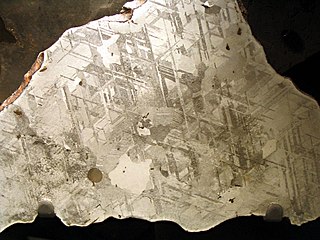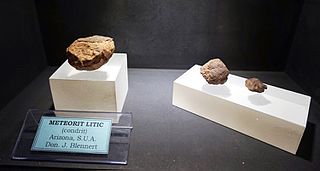Related Research Articles

Kamacite is an alloy of iron and nickel, which is found on Earth only in meteorites. According to the International Mineralogical Association (IMA) it is considered a proper nickel-rich variety of the mineral native iron. The proportion iron:nickel is between 90%:10% and 95%:5%; small quantities of other elements, such as cobalt or carbon may also be present. The mineral has a metallic luster, is gray and has no clear cleavage although its crystal structure is isometric-hexoctahedral. Its density is about 8 g/cm3 and its hardness is 4 on the Mohs scale. It is also sometimes called balkeneisen.

In meteoritics, a meteorite classification system attempts to group similar meteorites and allows scientists to communicate with a standardized terminology when discussing them. Meteorites are classified according to a variety of characteristics, especially mineralogical, petrological, chemical, and isotopic properties.

A chondrite is a stony (non-metallic) meteorite that has not been modified, by either melting or differentiation of the parent body. They are formed when various types of dust and small grains in the early Solar System accreted to form primitive asteroids. Some such bodies that are captured in the planet's gravity well become the most common type of meteorite by arriving on a trajectory toward the planet's surface. Estimates for their contribution to the total meteorite population vary between 85.7% and 86.2%.

A micrometeorite is a micrometeoroid that has survived entry through the Earth's atmosphere. Usually found on Earth's surface, micrometeorites differ from meteorites in that they are smaller in size, more abundant, and different in composition. The IAU officially defines meteoroids as 30 micrometers to 1 meter; micrometeorites are the small end of the range (~submillimeter). They are a subset of cosmic dust, which also includes the smaller interplanetary dust particles (IDPs).

Carbonaceous chondrites or C chondrites are a class of chondritic meteorites comprising at least 8 known groups and many ungrouped meteorites. They include some of the most primitive known meteorites. The C chondrites represent only a small proportion (4.6%) of meteorite falls.
Meteoritics is the science that deals with meteors, meteorites, and meteoroids. It is closely connected to cosmochemistry, mineralogy and geochemistry. A specialist who studies meteoritics is known as a meteoriticist.

Heazlewoodite, Ni3S2, is a rare sulfur-poor nickel sulfide mineral found in serpentinitized dunite. It occurs as disseminations and masses of opaque, metallic light bronze to brassy yellow grains which crystallize in the trigonal crystal system. It has a hardness of 4, a specific gravity of 5.82. Heazlewoodite was first described in 1896 from Heazlewood, Tasmania, Australia.

The Lunar Magma Ocean (LMO) is the layer of molten rock that is theorized to have been present on the surface of the Moon. The LMO was likely present on the Moon from the time of the Moon's formation to tens or hundreds of millions of years after that time. The LMO was a thermodynamic consequence of the Moon's relatively rapid formation in the aftermath of a giant impact between the proto-Earth and another planetary body. As the Moon accreted from the debris from the giant impact, gravitational potential energy was converted to thermal energy. Due to the rapid accretion of the Moon, thermal energy was trapped since it did not have sufficient time to thermally radiate away energy through the lunar surface. The subsequent thermochemical evolution of the LMO explains the Moon's largely anorthositic crust, europium anomaly, and KREEP material.
Adhi Kot is a meteorite that fell on 1 May 1919 in the Punjab region, now in Pakistan. The meteorite fell at 32°16′N71°49′E at 12PM, 15 miles (24 km) north of station Nurpur, Shahpur District. It was classified as an enstatite chondrite type EH4.
CI chondrites, also called C1 chondrites or Ivuna-type carbonaceous chondrites, are a group of rare carbonaceous chondrite, a type of stony meteorite. They are named after the Ivuna meteorite, the type specimen. CI chondrites have been recovered in France, Canada, India, and Tanzania. Their overall chemical composition closely resembles the elemental composition of the Sun, more so than any other type of meteorite.
Robert Norman Clayton was a Canadian-American chemist and academic. He was the Enrico Fermi Distinguished Service Professor Emeritus of Chemistry at the University of Chicago. Clayton studied cosmochemistry and held a joint appointment in the university's geophysical sciences department. He was a member of the National Academy of Sciences and was named a fellow of several academic societies, including the Royal Society.

Toshiko K. Mayeda was a Japanese American chemist who worked at the Enrico Fermi Institute in the University of Chicago. She worked on climate science and meteorites from 1958 to 2004.
Jodzie is a meteorite that fell on 17 June 1877 near the village of Juodžiai near Panevėžys. It is a relatively rare howardite with some carbonaceous inclusions that were likely a result of an asteroid collision. Therefore, despite its small size, it has been a subject of several scientific studies.
Asteroidal water is water or water precursor deposits such as hydroxide (OH−) that exist in asteroids. The "snow line" of the Solar System lies outside of the main asteroid belt, and the majority of water is expected in minor planets. Nevertheless, a significant amount of water is also found inside the snow line, including in near-earth objects (NEOs).
CM chondrites are a group of chondritic meteorites which resemble their type specimen, the Mighei meteorite. The CM is the most commonly recovered group of the 'carbonaceous chondrite' class of meteorites, though all are rarer in collections than ordinary chondrites.
Hafnium–tungsten dating is a geochronological radiometric dating method utilizing the radioactive decay system of hafnium-182 to tungsten-182. The half-life of the system is 8.9±0.1 million years. Today hafnium-182 is an extinct radionuclide, but the hafnium–tungsten radioactive system is useful in studies of the early Solar system since hafnium is lithophilic while tungsten is moderately siderophilic, which allows the system to be used to date the differentiation of a planet's core. It is also useful in determining the formation times of the parent bodies of iron meteorites.
Gas-rich meteorites are meteorites with high levels of primordial gases, such as helium, neon, argon, krypton, xenon and sometimes other elements. Though these gases are present "in virtually all meteorites," the Fayetteville meteorite has ~2,000,000 x10−8 ccSTP/g helium, or ~2% helium by volume equivalent. In comparison, background level is a few ppm.
Ghislaine Crozaz is a cosmochemist known for her research on the early history of the solar system through tracking trace elements in meteorites.
Sachiko Amari is a Japanese astrophysicist who focuses upon presolar grains. She developed the method for isolating presolar grains in primitive meteorites and also researched noble gases in meteorites. Amari was awarded the Urey Medal by the European Association of Geochemistry in 2021. She currently is a Research Professor of Physics at Washington University in St. Louis.
Robert Hutchison was a British scientist who was the curator of Meteorites at the Natural History Museum. He received the Gold Medal of the Royal Astronomical Society in 2000, and published several popular books on meteorites.
References
- 1 2 Meteoritical Bulletin Database: Akbarpur
- ↑ Nair, Savithri Preetha (2006). "Science and the politics of colonial collecting: the case of Indian meteorites, 1856–70". The British Journal for the History of Science. 39 (1): 97–119. doi:10.1017/S0007087405007624. ISSN 1474-001X.
- ↑ Wahl, Walter (1952-01-01). "The brecciated stony meteorites and meteorites containing foreign fragments". Geochimica et Cosmochimica Acta. 2 (2): 91–117. Bibcode:1952GeCoA...2...91W. doi:10.1016/0016-7037(52)90002-1. ISSN 0016-7037.
- ↑ "Memoirs of the Geological Survey of India". 99. The Governor-General of India. 1969: 22.
{{cite journal}}: Cite journal requires|journal=(help)